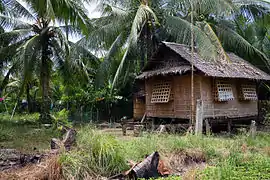Amakan
Amakan, also known as sawali in the northern Philippines, is a type of traditional woven split-bamboo mats used as walls, paneling, or wall cladding in the Philippines.[1] They are woven into various intricate traditional patterns, often resulting in repeating diagonal, zigzag, or diamond-like shapes. The term "sawali" is more properly defined as twilled weaving patterns. The term can also be applied to baskets and banig (soft woven mats made from pandan leaves, buri palm straw, abaca, or sedges), which also use the same weaving patterns.[2][3] Amakan panels are commonly confused with nipa walls, which are made from thatched leaves.
_1.jpg.webp)
_from_the_Philippines_06.jpg.webp)

Amakan are used as walls in the traditional nipa huts (bahay kubo) of the Philippines. They are lightweight and are porous, allowing air circulation to keep buildings cool in the hot tropical climate. The porosity also balances pressure inside the house during strong winds, minimizing roof damage.[4] Amakan needs to be treated before installation. They are soaked in seawater, dried, and then usually (but not always) varnished. They are usually affixed to a wooden framework, then battened with bamboo or coco lumber.[5]
Amakan is associated with lower income rural housing because it is inexpensive and easy to replace. It is not uncommon for amakan to also be used as a design element (usually as cladding or paneling) in modern Filipino architecture to portray a rustic, traditional and tropical aesthetic.[4][6][7] It also ecologically sustainable because it is made with bamboo.[5]
 A rural house in Aklan with plain amakan walls
A rural house in Aklan with plain amakan walls A rural house in Leyte with amakan sidings woven into diamond patterns
A rural house in Leyte with amakan sidings woven into diamond patterns A gift shop in Bohol with amakan walls
A gift shop in Bohol with amakan walls
.jpg.webp) A traditional Filipino house with amakan walls in Bohol
A traditional Filipino house with amakan walls in Bohol Sawali interior paneling in the Mabini Shrine, a traditional Filipino house (bahay kubo)
Sawali interior paneling in the Mabini Shrine, a traditional Filipino house (bahay kubo)
References
- "Batuan SLPA produces amakan for local and national trades". GOVPH. Department of Social Welfare and Development, Republic of the Philippines. Retrieved 23 April 2021.
- Miller, Hugo H.; Minier, John F.; Andes, U.S.; Muller, Theodore; Brezina, Alice (1913). Philippine Mats. Philippine Craftsman Vol. I, No. 1. Manila: Bureau of Printing.
- Parker, Luther (1914). Some Common Baskets of the Philippines. Philippine Craftsman Vol. III, No. 1. Manila: Bureau of Printing.
- "Use of Indigenous Filipino Materials and Methods in Building Green Homes". Buensalido Architects. Retrieved 23 April 2021.
- Plywood (PDF). Global Shelter Cluster. October 2014.
- "Can't get enough of the 'tiny house' bahay kubo? Check out this modern amakan house". GMA News Online. 25 August 2020. Retrieved 23 April 2021.
- "An Old Fashioned Pinoy Bahay Kubo In Palawan". RealLiving. 7 September 2017. Retrieved 23 April 2021.